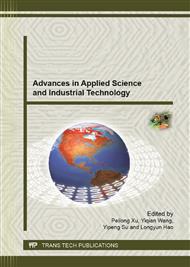[1]
Barney, J. : Firm resources and sustained competitive advantage, Journal of management, 17 (1), 99-120. (1991).
DOI: 10.1177/014920639101700108
Google Scholar
[2]
Berens, G. A. J. M., Corporate branding: the development of corporate associations and their influence on stakeholder reactions. Rotterdam: Erasmus University. (2004).
Google Scholar
[3]
Boyd, B. K., D. D. Bergh and D. J. Ketchen Jr , Reconsidering the Reputation—Performance Relationship: A Resource-Based View, Journal of management, 36 (3), 588-609. (2010).
DOI: 10.1177/0149206308328507
Google Scholar
[4]
Bromley, D. B. , Relationships between personal and corporate reputation, European Journal of Marketing, 35 (3/4), 316-34. (2001).
DOI: 10.1108/03090560110382048
Google Scholar
[5]
Brown, T. J. and P. A. Dacin , The company and the product: corporate associations and consumer product responses, Journal of Marketing, 61 (1), 68-84. (1997).
DOI: 10.1177/002224299706100106
Google Scholar
[6]
Capozzi, L. , Corporate reputation: our role in sustaining and building a valuable asset, Journal of Advertising Research, 45 (03), 290-93. (2005).
DOI: 10.1017/s0021849905050324
Google Scholar
[7]
Carroll, C. E. and M. McCombs , Agenda-setting effects of business news on the public's images and opinions about major corporations, Corporate Reputation Review, 6 (1), 36-46. (2003).
DOI: 10.1057/palgrave.crr.1540188
Google Scholar
[8]
Deephouse, D. L., Media reputation as a strategic resource: An integration of mass communication and resource-based theories, Journal of management, 26 (6), 1091-112. (2000).
DOI: 10.1177/014920630002600602
Google Scholar
[9]
Ditto, P. H. and D. F. Lopez, Motivated skepticism: Use of differential decision criteria for preferred and nonpreferred conclusions., Journal of Personality and Social Psychology, 63 (4), 568-84. (1992).
DOI: 10.1037/0022-3514.63.4.568
Google Scholar
[10]
Doney, P. M. and J. P. Cannon , An examination of the nature of trust in buyer-seller relationships, the Journal of Marketing, 62 (2), 35-51. (1997).
DOI: 10.1177/002224299706100203
Google Scholar
[11]
Figlewicz, R. E. and E. Szwajkowski, Systematic risk volatility and corporate reputation: A longitudinal and cross-sectional analysis, Organization Science Electronic Letters, 2 (1), 1-55. (2002).
Google Scholar
[12]
Fombrun, C. J. and C. van Riel , Fame and Fortune: How successful companies build winning reputations. Upper Saddle River, NJ: Financial Times Prentice-Hall. (2004).
Google Scholar
[13]
Fombrun, C. and M. Shanley , What's in a name? Reputation building and corporate strategy, Academy of management Journal, 33, 233-58. (1990).
DOI: 10.2307/256324
Google Scholar
[14]
Gibson, D., J. L. Gonzales and J. Castanon, The importance of reputation and the role of public relations, Public relations quarterly, 51 (3), 15. (2006).
Google Scholar
[15]
Gotsi, M. and A. M. Wilson, Corporate reputation: seeking a definition, Corporate Communications: An International Journal, 6 (1), 24-30. (2001).
DOI: 10.1108/13563280110381189
Google Scholar
[16]
Grunig, J. E., Image and substance: From symbolic to behavioral relationships, Public relations review, 19 (2), 121-39. (1993).
DOI: 10.1016/0363-8111(93)90003-u
Google Scholar
[17]
Highhouse, S., M. E. Brooks and G. Gregarus, An organizational impression management perspective on the formation of corporate reputations, Journal of Management, 35 (6), 1481-93. (2009).
DOI: 10.1177/0149206309348788
Google Scholar
[18]
Kay, J., Foundations of corporate success: How business strategies add value. Oxford: Oxford Paperbacks. (1995).
DOI: 10.1093/019828988x.001.0001
Google Scholar
[19]
Keh, H. T. and Y. Xie, Corporate reputation and customer behavioral intentions: The roles of trust, identification and commitment, Industrial Marketing Management, 38 (7), 732-42. (2009).
DOI: 10.1016/j.indmarman.2008.02.005
Google Scholar
[20]
Mahon, J. F., Corporate Reputation Research Agenda Using Strategy and Stakeholder Literature, Business & Society, 41 (4), 415-45. (2002).
DOI: 10.1177/0007650302238776
Google Scholar
[21]
Musteen, M., D. K. Datta and B. Kemmerer, Corporate reputation: do board characteristics matter? British Journal of Management, 21 (2), 498-510. (2009).
DOI: 10.1111/j.1467-8551.2009.00676.x
Google Scholar
[22]
Nisbett, R. E. and T. D. Wilson, The halo effect: Evidence for unconscious alteration of judgments, Journal of personality and Social Psychology, 35 (4), 250-56. (1977).
DOI: 10.1037/0022-3514.35.4.250
Google Scholar
[23]
Podnar, K., U. Tuškej and U. Golob, Mapping semantic meaning of corporate reputation in global economic crisis context: A Slovenian study, Public Relations Review, 38 (5), 906-15. (2012).
DOI: 10.1016/j.pubrev.2012.08.003
Google Scholar
[24]
Rindova V.P.,I.O. Williamson A.P. Petkova, andJ.M. Sever, Being good or being known: An empirical examination of the dimensions, antecedents and consequences of organizational reputation, Academy of Management Journal, 48(6), 1033-49. (2005).
DOI: 10.5465/amj.2005.19573108
Google Scholar
[25]
Roberts, P.W. and G.R. Dowling, Corporate reputation and sustained superior financial performance: Strategic management journal, 23(12), 1077-93. (2002).
DOI: 10.1002/smj.274
Google Scholar
[26]
Srivastava R.K.,T.H. McInish R.A. Wood, andA.J. Capraro, How Do Reputations Affect Corporate Performance?The Value of Corporate Reputation: Evidence from the Equity Markets, Corporate Reputation Review, 1(1), 61-68. (1997).
DOI: 10.1057/palgrave.crr.1540018
Google Scholar
[27]
Turban D.B. and D.W. Greening, Corporate social performance and organizational attractiveness to prospective employees: Academy of Management Journal, 40(3), 658-72. (1997).
DOI: 10.5465/257057
Google Scholar
[28]
Walker,K., A systematic review of the corporate reputation literature: Definition, measurement, and theory: Corporate Reputation Review, 12(4), 357-87. (2010).
DOI: 10.1057/crr.2009.26
Google Scholar
[29]
Walsh,G. and S.E. Beatty, Customer-based corporate reputation of a service firm: scale development and validation: Journal of the academy of Marketing Science, 35 (1), 127-43. (2007).
DOI: 10.1007/s11747-007-0015-7
Google Scholar
[30]
Wartick S.L., Measuring Corporate Reputation Definition and Data: Business & Society, 41(4), 371-92. (2002).
DOI: 10.1177/0007650302238774
Google Scholar
[31]
Zinkhan G.M.,J. Ganesh,A. Jaju and L. Hayes, Corporate image, A conceptual framework for strategic planning: in Conference proceedings Vol. 12. Chicago, IL. (2001).
Google Scholar
[32]
Zheng Fang, Yang Yang, Minghua Jang, Wei Li, Shan Li, Defensible product harm crisis response strategy research on the influence of brand equity: regulated variable and intervening variable role, Nankai Business Review, 2011, 14(4), 69-79.
Google Scholar


